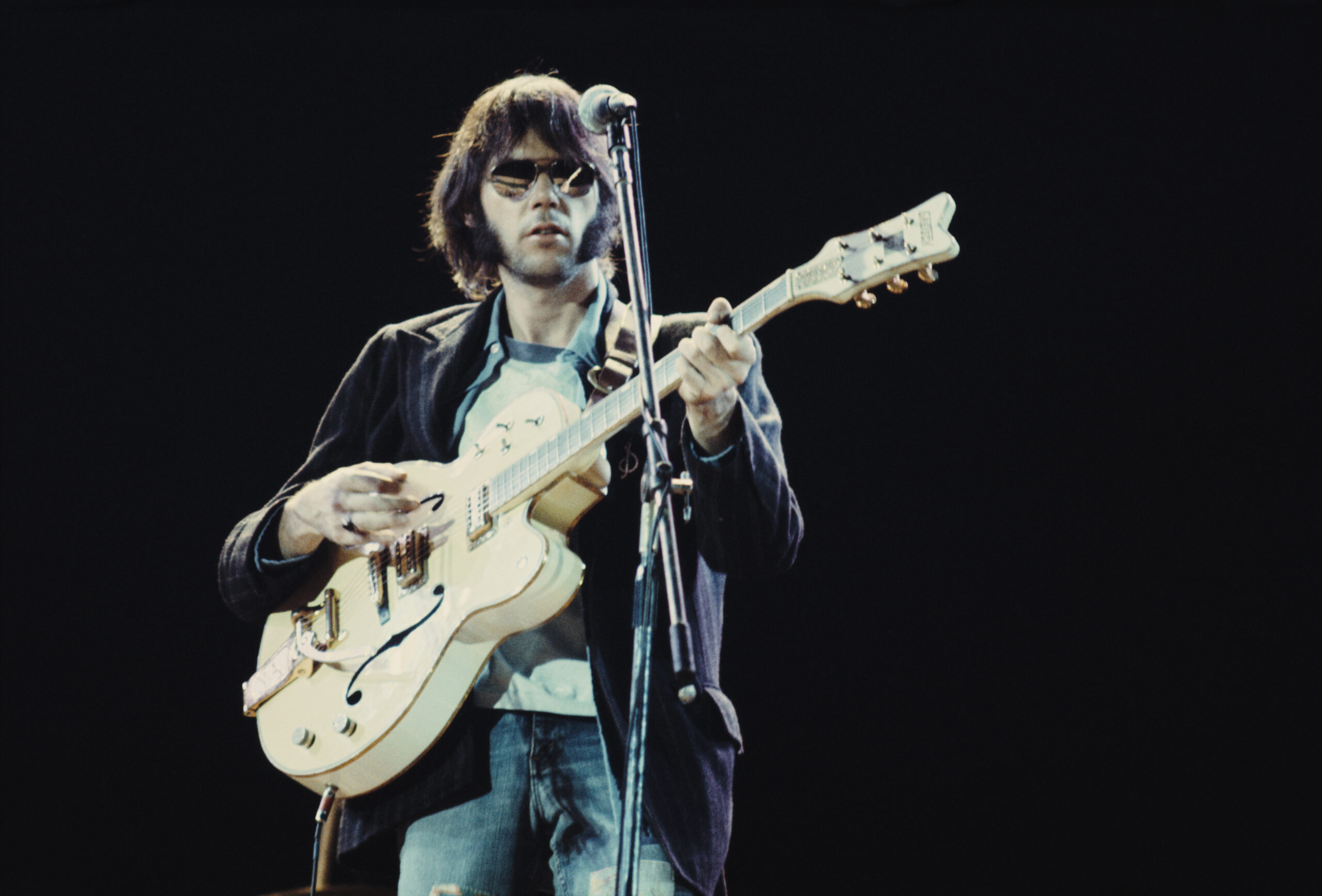
Neil Percival Young grew up in Winnipeg, but he moved to America in the ‘60s to become the greatest rock star Canada has ever produced. For over 50 years, he’s remained restlessly creative and committed to his political ideals, an influential guitarist as adept at heartbreaking ballads as fiery protest songs. While other classic rockers have slowed down their output, Young has remained ever-prolific, releasing nine albums in just the last decade.
Neil Young’s latest album, Barn, with longtime backing band Crazy Horse, was released in December. But in recent weeks he’s been in the news more for taking a stand against Spotify, removing his music from the streaming service over its backing of controversial podcaster Joe Rogan. Fortunately, there are still a lot of ways to enjoy the songwriter’s vast catalog, including his own Neil Young Archives service.
We’ve ranked 42 albums here: all of Young’s studio records as a solo artist or bandleader, plus some live albums that contained all-new material like Time Fades Away and Rust Never Sleeps. That includes a dozen albums with Crazy Horse and one-off collaborations with bands ranging from Pearl Jam to Booker T. & The M.G.’s. The list does not, however, include his work as a member of Buffalo Springfield or Crosby, Stills, Nash & Young, film soundtracks, scrapped albums unearthed for the Archives series, or the live albums of familiar favorites.
42. Landing On Water (1986)
[embedded content][embedded content]
In the 1980s, many ‘60s and ‘70s rock icons released their biggest multi-platinum albums thanks to MTV and polished, synth-heavy production. But a maverick like Young could probably never thrive in the ultra-conformist ‘80s, and he spent almost the entire decade in an experimental wilderness. Even his most overtly ‘80s-sounding album, Landing On Water, feels sickly and off, using clanging Synclavier textures poorly suited to songs Young first tried recording with Crazy Horse in 1984. While 1982’s Trans had a big heart underneath its chilly, futuristic exterior, Landing on Water is as rigid and soulless as Young’s music has ever gotten.
41. Are You Passionate? with Booker T. & The M.G.’s (2002)
[embedded content][embedded content]
Are You Passionate? features an intriguing pairing that’s full of potential: Young and Booker T. & The M.G.’s, the Memphis soul combo behind instrumental hits like “Green Onions” and other Stax Records classics by Otis Redding and Sam & Dave. Booker T. Jones’ iconic organ tone and Donald “Duck” Dunn’s busy, melodic bass lines give Passionate a sound like any other Young album, soothing and steady. But the downbeat material doesn’t quite click with the band, and the album’s most famous song is its low point: “Let’s Roll,” an awkward attempt at an inspiring ode to the United Flight 93 passengers who died on 9/11. “The songs are too long, too slow, and they all sound the same,” wrote The Austin Chronicle’s Raoul Hernandez.
40. Psychedelic Pill with Crazy Horse (2012)
[embedded content][embedded content]
At 87 minutes, Psychedelic Pill is Young’s longest studio album, a feat never justified across nine rambling tracks. The poorly mixed transition from an acoustic intro into the full electric band during minute two of “Driftin’ Back” is one of Young’s sloppiest moments that doesn’t manage to sound accidentally charming or artful. And the 27-minute song never really gets any better, with lyrics that gripe about big tech and MP3s before climaxing with the refrain of “Gonna get me a hip-hop haircut.”
39. Hawks & Doves (1980)
[embedded content][embedded content]
Young’s first album of the ‘80s was partly leftovers from the previous decade. The first side of Hawks & Doves features acoustic songs from two albums Young had recorded and shelved in the mid-‘70s, Hitchhiker and Homegrown (which were eventually released in 2017 and 2020, respectively, as part of his Archives campaign). And even with some irritatingly chipper new songs recorded in 1980 for side two, Hawks & Doves feels slight and unfinished. The album’s muddled origins lead to music that leaves little impression, aside from the haunting “The Old Homestead” with The Band’s Levon Helm on drums.
38. Fork in the Road (2009)
[embedded content][embedded content]
Ford in the Road is a concept album of sorts, with a companion documentary of the same name, about Neil Young’s 1959 Lincoln Continental that was converted into a hybrid electric vehicle. In practice, however, with songs like “Get Behind the Wheel,” Fork feels like an old-fashioned rock record about the romance of the road. It’s probably Young’s hardest-rocking late-period album without Crazy Horse, and “Just Singing a Song” has a great, surging energy. But Fork in the Road is ultimately low on inspiration and just as monotonous as a long road trip.
37. Re·ac·tor with Crazy Horse (1981)
[embedded content][embedded content]
Rock production was becoming bigger and cleaner in the 1980s, an approach that did Crazy Horse’s wooly aesthetic no favors. And the band’s never been captured in the studio more unflatteringly than on Re·ac·tor, with fuzzed-out guitar riffs flanked by Synclavier and a whole lot of handclaps. Forgettable songs like “Surfer Joe and Moe the Sleaze” don’t help the band rise above the production, itself just a tentative step towards the bigger, weirder leap Young would take a year later with Trans.
36. Living With War (2006)
[embedded content][embedded content]
Seventeen years after Young criticized the George H.W. Bush administration on Freedom, he reunited with some of that album’s supporting cast — including co-producer Niko Bolas and rhythm section Rick Rosas and Chad Cromwell — to denounce the George W. Bush administration. From “Let’s Impeach the President” to “Shock and Awe,” Living With War might be Young’s most single-minded protest album: righteous and unflinching. But while Tommy Bray’s lone trumpet offers a military edge to these calls for peace, it sounds awkward over roaring guitars, and nothing here has the anthemic heft of “Rockin’ in the Free World.”
35. Americana with Crazy Horse (2012)
[embedded content][embedded content]
Americana arrived nearly nine years after Greendale, the longest Neil Young has ever gone without a Crazy Horse album (though band members did appear on albums in between). And they reunited for an unusual project, covering 11 of the most famous folk songs in the English language, from “Oh Susannah” to “This Land Is Your Land.” Young had a high-minded intent when revisiting these familiar, deceptively simple songs: “Every one of those songs has verses that has been ignored,” he told MSN. “The originals are much darker, there’s more protest in them.” As much as I respect the concept of Americana, however, a roaring Crazy Horse take on “Clementine” winds up bordering on self-parody, the material deeply at odds with the arrangements.
34. Everybody’s Rockin’ with The Shocking Pinks (1983)
[embedded content][embedded content]
In one of the most famous artist/label conflicts in rock music history, Geffen Records demanded a rock ‘n’ roll album from Young after 1982’s divisive, experimental Trans. Young responded with Everybody’s Rockin’, a defiantly retro rockabilly album featuring songs made famous by Jimmy Reed and Elvis Presley, along with originals in the same mold. A furious David Geffen sued Young for over $3 million for turning in “uncharacteristic” records, despite having promised the singer creative freedom in his contract. Geffen eventually apologized and continued releasing whatever albums Young wanted to make. It’s a watershed moment for artists’ rights, but the 25-minute Everybody’s Rockin’, Young’s shortest studio album, has always stood more as a symbolic statement than a record worth listening to.
33. Life with Crazy Horse (1987)
[embedded content][embedded content]
Young’s second Crazy Horse album of the ‘80s had slightly better songs than Re·ac·tor. But the decade’s bombastic production trends were even more pronounced on Life, despite many of the basic tracks being recorded live onstage. The gated, Phil Collins-styled snare sound is a terrible fit for Ralph Molina’s playing style, and the album’s first two politically charged songs are full of cheesy cannon sound effects. But the final album from Young’s troubled Geffen tenure includes “Prisoners of Rock ‘N’ Roll” as a hilariously perfect parting shot: “We never listen to the record company man; they try to change us and ruin our band / That’s why we don’t wanna be good.”
32. A Letter Home (2014)
[embedded content][embedded content]
Young’s most lo-fi album is a little bit high-concept. When Jack White bought and restored a Voice-o-Graph vinyl recording booth built in 1947, he invited Young to make a record with it. Treating it like a phone booth where he could speak to his late mother, Young sits with his acoustic guitar and sings a collection of cover songs to Edna “Rassy” Young. There’s an eerie beauty to the faded, hissy sound of Young singing his favorite Dylan, Springsteen, and Everly Brothers songs as a loving message to the afterlife — but still, it can wear on you over the course of the album. “The noisier approach feels like needless gimmickry that diminishes, rather than enhances, one of his strongest sets in a long time,” wrote Jon Young in the SPIN review.
31. Colorado with Crazy Horse (2019)
[embedded content][embedded content]
Nils Lofgren played with Neil Young and Crazy Horse in the ‘70s before launching his solo career and becoming a sideman for another legendary artist, Bruce Springsteen. So when longtime Crazy Horse guitarist Frank “Poncho” Sampedro retired and moved to Hawaii after touring behind 2012’s Psychedelic Pill, Lofgren was a natural choice to step back in. The latest form of Crazy Horse boasts some of the band’s best vocal harmonies to date on Colorado, and the album has a relaxed, unhurried air, with Young playing vibraphone on the lovely “Green Is Blue.”
30. Time Fades Away (1973)
[embedded content][embedded content]
In the liner notes for 1977’s Decade, Neil Young wrote about how he abruptly changed course after scoring a #1 single: “’Heart of Gold’ put me in the middle of the road. Traveling there soon became a bore, so I headed for the ditch.” What became known as the “Ditch Trilogy” of commercially unsuccessful post-Harvest albums kicked off with Time Fades Away, a project Young disliked so much that it stayed out of print for decades. As a set of all-new songs recorded live on tour, one of the first albums of its kind from a major artist, Time Fades Away was a big gamble, and “L.A.” and “Journey Through the Past” hint at how great it could have been. But between Young’s lack of live chemistry with the Stray Gators, a highly-paid band of pro session musicians, and his depression over the death of Crazy Horse’s Danny Whitten just before the tour, a dark cloud hangs over the album.
29. Peace Trail (2016)
[embedded content][embedded content]
Jim Keltner has been one of music’s most revered session drummers since the 1970s, but he didn’t cross paths with Young until backing him on tour in the ‘90s. In 2016, Young, Keltner. and bassist Paul Bushnell convened for four days and made Peace Trail. A compact little trio album, it displays Keltner’s playing at its most creative, spontaneously building backdrops to Young’s spare songs. But it also finds Young at his most cantankerous, sounding like he just opened a newspaper and wrote a song about every story that pissed him off.
28. Broken Arrow with Crazy Horse (1996)
[embedded content][embedded content]
The death of longtime friend and producer David Briggs spurred Young to reunite with Crazy Horse for his last album of the 20th century, before an unusual lull in recording in the late ‘90s. The cavernous production on Broken Arrow buries the vocals, but there’s life in Young’s rambling guitar duels with Frank “Poncho” Sampedro. “Broken Arrow” was one of the most ambitious early songs Neil Young wrote for Buffalo Springfield, but the album that shared its title three decades later feels like business as usual. “Undeniable yes, irresistible no,” Robert Christgau wrote witheringly of Broken Arrow.
27. The Monsanto Years with Promise Of The Real (2015)
[embedded content][embedded content]
In the mid-‘80s, before Lukas and Micah Nelson were born, their father Willie Nelson befriended Young, collaborating on music and co-founding Farm Aid to benefit American family farmers. Decades later, Lukas and Micah’s band Promise of the Real backed Young on two albums. And to bring things even more full circle, The Monsanto Years is a concept album taking aim at agribusiness giant Monsanto’s negative impact on the farming industry. Young sounds energized by having a much younger backing band around him. And “People Want to Hear About Love” is a fascinatingly self-aware song about the push and pull between his drive to sing topical songs about current events, and the popular demand for emotional songwriting with more universal themes.
26. The Visitor with Promise Of The Real (2017)
[embedded content][embedded content]
“This is not simply a collection of protest songs, and even its more pointed tracks tend to zoom out, incorporating political observations as stray thoughts,” wrote Sam Sodomsky in the Pitchfork review of The Visitor. The album is in part Neil Young’s celebration of America from the perspective of a man born in Canada and in part a rebuke to the Donald Trump administration. But The Visitor also builds on Young’s chemistry with Promise of the Real, who bring some different textures to the proceedings, including Lukas Nelson’s glockenspiel on “Fly by Night Deal.”
25. This Note’s For You with The Bluenotes (1988)
[embedded content][embedded content]
One of Young’s most accessible albums of the ‘80s was, ironically, a satire of selling out. The title track of This Note’s For You takes aim at the rising trends of major rock tours sponsored by beer companies and soda commercials starring pop singers, with a comical video featuring Michael Jackson and Whitney Houston lookalikes. MTV initially banned the video amidst fears of legal threats from Jackson, before ultimately airing the clip and even making it Video of the Year at the 1989 VMAs. Young sounds like he’s having fun with his bluesy new band and horn section The Bluenotes (not to be confused with ‘70s R&B hitmakers Harold Melvin & The Blue Notes). But the quiet, jazzy moments like “Coup de Ville” and “Twilight” are by far the best parts of an otherwise slick and loud album.
24. Barn with Crazy Horse (2021)
[embedded content][embedded content]
Young’s most recent album was his first made during the pandemic, with Crazy Horse writing and recording in an open-air barn in Colorado. The current incarnation of Crazy Horse is gentler and prettier: A back-in-the-fold Lofgren is often on piano or accordion instead of second guitar, and with its lucid moments of reflection, “They Might Be Lost” is a classic example of stream-of-consciousness Young. For most of that song, Young is waiting for a late guest to arrive and speculating on their whereabouts, until a poignant observation comes out of nowhere: “The jury’s out on the old days, you know / The judgment is soon coming down.”
23. Prairie Wind (2005)
[embedded content][embedded content]
Mortality looms ominously over Prairie Wind. Young began writing the album as his father was dying, but during sessions, Neil himself suffered a brain aneurysm and had to undergo surgery. After recovering, he began performing a new song inspired by his brush with death, “When God Made Me,” which closes Prairie Wind. “No Wonder” provides some of those surreal late-period Young moments — did he really just sing, “I’ll always remember something Chris Rock said”?
22. Old Ways (1985)
[embedded content][embedded content]
Seven years before Harvest Moon, Young released a less successful acoustic album that was in some ways a deliberate throwback to Harvest — tellingly, The International Harvesters was the name of Young’s backing band for Old Ways and the following tour. The first time Young submitted the record to Geffen Records in 1983, the label balked at country songs with an all-star supporting cast including Willie Nelson and Waylon Jennings, asking him for a rock project instead. But two years later, Young had won his legal battle with Geffen and released a reworked Old Ways in the summer of ’85, a month after Crosby, Stills, Nash & Young reunited at Live Aid and triggered a wave of nostalgia for Young’s acoustic work. Unfortunately, Old Ways was overproduced with schmaltzy string arrangements, and it went down as a commercial and critical failure.
21. Storytone (2014)
[embedded content][embedded content]
Most of Young’s 21st century albums have veered between the two established poles of electric and acoustic guitar. But Storytone is a rare late-period experiment, seven songs with a symphony orchestra and three with a jazzy big band including a horn section. The result: some of Young’s best vocal performances in decades against a novel backdrop, with vulnerable lyrics reflecting on his divorce from Pegi Young and his new relationship with Daryl Hannah.
20. Comes a Time (1978)
[embedded content][embedded content]
If any Young album’s reputation has shrunk over the years, it’s Comes a Time. In 1978, it was his highest-charting album since Harvest, placing eighth on The Village Voice’s Pazz & Jop critics poll and welcomed as a return to form after a commercial downturn. It’s a gorgeous acoustic LP, with light rhythm section accompaniment added at Reprise’s suggestion. And the melodies are sweetened by backing vocals from Nicolette Larson, whose cover of Comes a Time’s “Lotta Love” became a major pop hit a few months later. But in the grand Young mythos, the record has become a minor work, a rare moment when he took notes from the label and it all worked out.
19. Neil Young (1968)
[embedded content][embedded content]
Some legends hit the ground running on their debut album, while others were still getting warmed up. Young’s self-titled LP pales in comparison to the run of classics that immediately followed – it missed the charts completely, and he was so dissatisfied with the mix that a remixed version was pressed two months after the initial release. But “The Old Laughing Lady” and “The Last Trip To Tulsa” offer a fascinating glimpse at a 22-year-old songwriter quickly emerging from the shadow of Stephen Stills after Buffalo Springfield.
18. Silver & Gold (2000)
[embedded content][embedded content]
After an unusually long four-year break from solo albums following Broken Arrow, Young was in a nostalgic mood. Crosby, Stills, Nash & Young reunited for an album in 1999, and a year later on Silver & Gold, Young sang about getting another old band back together on “Buffalo Springfield Again” (That group eventually did perform again, in 2010 and 2011). Silver & Gold was probably Young’s last really polished and accessible album before he veered hard toward looser performances and relentlessly topical lyrics. And “Razor Love” has emerged as one of Young’s most enduring songs of the 21st century.
17. Ragged Glory with Crazy Horse (1990)
[embedded content][embedded content]
Young kicked off the ’90s with Ragged Glory, an album that cemented him as a foundational influence on the decade’s dominant alt-rock bands. He toured with Sonic Youth to support the record, and Pearl Jam later frequently covered “Fuckin’ Up.” With simple, hard-hitting garage rock production and big, twangy riffs, Crazy Horse finally sounded like themselves again after the misfires of Re·ac·tor and Life.
16. Chrome Dreams II (2007)
[embedded content][embedded content]
Of all of the albums Young worked on but didn’t release in the ‘70s, Chrome Dreams is the most storied, a bootlegged acetate containing early versions of future classics like “Powderfinger” and “Like a Hurricane.” Thirty years after the original Chrome Dreams, Young released a sequel to the album that wasn’t — not of the same material but a completely different set of tunes, some recent and some dating back to the ‘80s. Despite its origins in obscure Young lore, Chrome Dreams II stands on its own as a late period high point, wide-ranging and energetic. And the 18-minute “Ordinary People” is a different kind of Young epic, with great use of The Blue Notes’ brass section from This Note’s For You.
15. Mirror Ball with Pearl Jam (1995)
[embedded content][embedded content]
Young’s ‘90s renaissance as “The Godfather of Grunge” peaked by uniting with Pearl Jam, at the time the biggest band in the world, first at the 1993 MTV Video Music Awards and then for an entire 1995 album. Mirror Ball was Pearl Jam’s first recording with former Red Hot Chili Peppers drummer Jack Irons. And it was their perfect lineup to back Young, who raved that Irons was “unbelievable.” Though they played on Pearl Jam’s turf, recording in Seattle with their go-to producer Brendan O’Brien, it’s very much a Young album, and “I’m The Ocean” is a strong contender for his best song of the ‘90s.
14. Greendale with Crazy Horse (2003)
[embedded content][embedded content]
The rock opera was born around the same time Young’s career got started, but it took him over 30 years to make his own. Of course, a Neil Young rock opera isn’t necessarily much like a Pete Townshend rock opera. Greendale is a latter-day Crazy Horse album with familiar chugging riffs and explicit left-wing politics, but Young frames the songs in an ambitious storyline about the Green family in the fictitious town of Greendale, California. Greendale has become something of a cottage industry unto itself over the last two decades, spinning off a film directed by Young, a graphic novel, and a Return to Greendale live album in 2020.
13. Sleeps With Angels with Crazy Horse (1994)
[embedded content][embedded content]
From the opening tack piano notes of “My Heart,” the last album Neil Young produced with the late David Briggs consciously evokes the wounded melancholy of After the Gold Rush. And that mood is enhanced by the last song recorded for the album, the title track — Young’s mournful response to being quoted in Kurt Cobain’s suicide note. Young often wielded Sampedro-era Crazy Horse like a blunt instrument, but Sleeps With Angels captures the full range of their sensitivity and versatility.
12. American Stars ‘n Bars with Crazy Horse (1977)
[embedded content][embedded content]
In the mid-‘70s, an especially indecisive Young recorded and then abandoned a series of albums that went unreleased for decades: Homegrown, Hitchhiker, and Chrome Dreams. Then he finally released American Stars ‘n Bars, combining songs from those shelved projects with new material, packaged in a memorably odd cover designed by actor Dean Stockwell. The seams show a bit too much in the other album stitched together from songs from that period, 1980’s Hawks & Doves. But American Stars ‘n Bars holds together nicely thanks to an expanded Crazy Horse lineup and the roaring classic “Like A Hurricane.”
11. Harvest Moon (1992)
[embedded content][embedded content]
It wasn’t quite Bat Out of Hell II, but Harvest Moon was Neil Young at his cuddliest and most accommodating, marking the 20th anniversary of his biggest album with a sequel of sorts. Harvest Moon doesn’t exactly recreate the Harvest sound — it’s a more single-minded record, without any hard-rocking outliers like “Alabama,” for one — but most of his ‘72 supporting cast is present. And the songs, including “From Hank To Hendrix” and “War of Man,” are beautiful, bittersweet, and instantly memorable. The swooning title track marked Young’s only Grammy nominations for Song and Record of the Year, losing to “A Whole New World” and “I Will Always Love You,” respectively.
10. Trans (1982)
[embedded content][embedded content]
In 1982, Trans was met with skepticism, confusion, and even outrage from many fans, the famous roots rocker singing songs like “Transformer Man” and “Computer Age” through a vocoder over icy synthesizers. But the misunderstood album was rooted in Young’s relationship with his son Ben, who’d been diagnosed with cerebral palsy and was unable to speak. The extended mechanical Kraftwerk grooves were inspired by the repetition of Ben’s therapy program, while the garbled digital vocals reflected their difficulty communicating with each other. Three songs from the shelved album Islands in the Sun, including opening track “Little Thing Called Love,” make Trans an odd mix of styles. But the album’s futuristic sections hold up as prescient and influential.
9. Le Noise (2010)
[embedded content][embedded content]
Few people know as much about exploiting the expressive possibilities of guitars, amps, and reverb as Neil Young. Daniel Lanois is one — so he was the perfect choice to produce Le Noise, Young’s only album consisting almost purely of vocals and electric guitar with no backing musicians. Throughout, Young’s hollow-body Gretsch hums and squawks while his voice pings around the track in pieces of delayed debris, a stunning and unusually beautiful sound.
8. Tonight’s The Night (1975)
[embedded content][embedded content]
Tonight’s The Night introduces the kind of offhanded spontaneity and first-take imperfections that would define many of Young’s later albums, in deep contrast to the ‘70s studio professionalism that was coming into vogue. It was also the first studio LP Young submitted to his label after the blockbuster Harvest, and Reprise was understandably reluctant, taking nearly two years to release it. But Tonight’s The Night, recorded shortly after the overdose deaths of roadie Bruce Berry and Crazy Horse guitarist Danny Whitten, is a raw nerve of pure grief, almost unnerving in its unflinching intimacy.
7. Freedom (1989)
[embedded content][embedded content]
After spending almost the entire 1980s in the critical and commercial wilderness, Young ended the decade with his first gold album in 10 years. The instant classic “Rockin’ in the Free World” bookends the album in two versions, but elsewhere Young fills Freedom with a textured and varied set, including some of his liveliest and most inventively arranged acoustic songs.
6. Rust Never Sleeps with Crazy Horse (1979)
[embedded content][embedded content]
Time Fades Away may have been a largely unsuccessful experiment in recording new songs onstage. But Young tried again on Rust Never Sleeps, with two key differences. This time, he had the reliable Crazy Horse with him, and the album mirrored the structure of their concerts, with acoustic songs followed by an explosive electric set. “For anyone still passionately in love with rock & roll, Neil Young has made a record that defines the territory,” Paul Nelson wrote in the Rolling Stone review.
5. Harvest (1972)
[embedded content][embedded content]
The huge commercial success of Harvest, and the way Young spent the next few years swerving away from it, have marked it as the entry-level album for casual fans. But Harvest presents a complete a picture of his enormous talent, from the fragile “The Needle and the Damage Done” to the sweeping, orchestral “There’s a World” and the loose, jammy “Words.” The lyrics of “Alabama” and “A Man Needs a Maid” have made Harvest a perennial object of passionate debate, but the album’s musical riches can’t be denied.
4. On the Beach (1974)
[embedded content][embedded content]
The crown jewel of the so-called “Ditch Trilogy” wasn’t necessarily designed to flop. Young submitted On the Beach to Reprise as a more palatable replacement for Tonight’s the Night, accepted the suggestion to swap the A and B sides to put the uptempo single “Walk On” up front, and gave it a whimsical cover photo of a Cadillac buried under sand. But the album’s darkness is an acquired taste, from the desolate title track to “Revolution Blues,” inspired by Young’s encounter with Charles Manson before the Manson Family murders.
3. Zuma with Crazy Horse (1975)
[embedded content][embedded content]
Crazy Horse’s sturdy rhythm section of bassist Billy Talbot and drummer Ralph Molina tried a few different configurations of the band after guitarist Danny Whitten’s death, including briefly changing the band name to Santa Monica Flyers. But when guitarist Frank “Poncho” Sampedro joined the band before the recording of Zuma, their chemistry with Young and each other was immediate, flourishing for the next 40 years. Zuma opens with lyrics Young penned in high school on “Don’t Cry No Tears,” followed by “Danger Bird,” freshly written about his breakup with Carrie Snodgress. But Zuma’s inarguable masterpiece is the cinematic epic “Cortez the Killer,” perhaps the perfect distillation of the Crazy Horse sound.
2. After the Gold Rush (1970)
[embedded content][embedded content]
There’s something special about Young’s voice when he slips into a near-falsetto register, his voice quavering with the kind of vulnerability that can’t be faked. After the Gold Rush may be the Young album most likely to reduce a listener to tears, whether from “Birds” or the timeless “Only Love Can Break Your Heart.” The title track is an early example of the environmentalism that would inform Young’s songwriting for decades to come, while “Southern Man” was the first of a couple of fiery anthems that would prompt a sharp response from Lynyrd Skynyrd.
1. Everybody Knows This Is Nowhere with Crazy Horse (1969)
[embedded content][embedded content]
It’s an understatement to say that Young has had some good days as a songwriter. But he’s probably never had a more legendary day than the one in early 1969 when, battling a 103–degree fever, he managed to write four of his greatest songs, all of which appear on Everybody Knows This is Nowhere. “Cinnamon Girl” and the title track introduce Crazy Horse to the world with massive, jangly hooks, while the nine-minute “Down by the River” and the 10-minute “Cowgirl in the Sand” are Young’s first truly epic rockers.
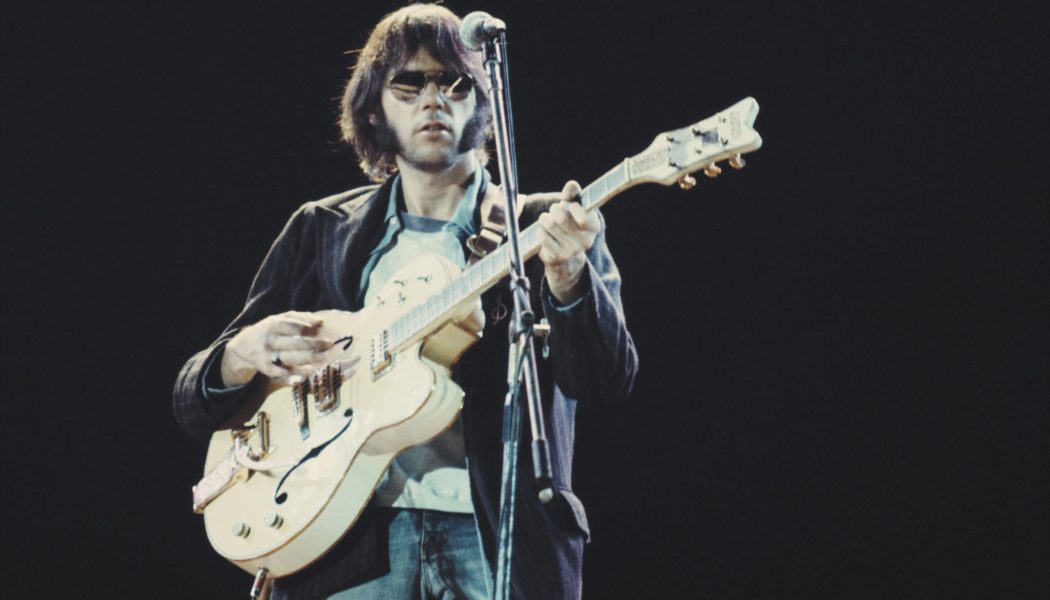



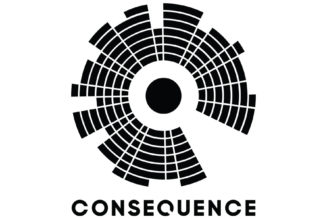
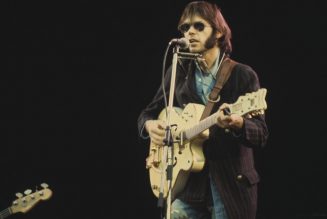


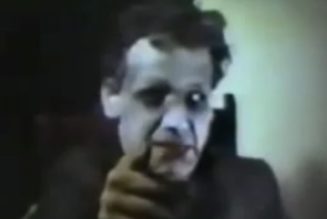


Tagged: Lists, Neil Young, Neil Young with Crazy Horse